
Their free, easy-to-use copyright licenses provide a simple, standardized way to give the public permission to share and use your creative work — on conditions of your choice. CC licenses let you easily change your copyright terms from the default of “all rights reserved” to “some rights reserved.”
Creative Commons licenses are not an alternative to copyright. They work alongside copyright and enable you to modify your copyright terms to best suit your needs.
(Text taken from the Creative Commons website)
Use Creative Commons for Educators and Librarians for an in-depth look at Creative Commons.
What Is Creative Commons? by Victor Grigas from YouTube is available under a Creative Commons Attribution-ShareAlike 3.0 Unported license.

(Creative Commons Infographic from: Technology Enhanced Learning Blog)

Creative Commons licenses are designed for ease of use. Users can see in a transparent manner how your work is available for reuse. Things can become complicated however if you want to combine two Creative Commons licensed works, for example when making a collage or remixes of music. Not all licenses are in fact compatible. In the chart below we show which licenses are compatible.
Choose two works you wish to combine or remix. Find the license of the first work on the first row and the license on the first column. You can combine the works if there is a check mark in the cell where the row and column intersect. Use at least the most restrictive licensing of the two (use the license most to the right or down) for the new work. If there is a cross at the intersection of the row and column, then you cannot combine these works. This probably indicates that one of the two licenses may not be used for commercial purposes, or one of the licenses does not allow for derivative works to be created
It is not possible to mix works where the first work is placed under a Creative Commons Attribution-Share Alike license and the second work is licensed under a Attribution-NonCommercial-ShareAlike license. The ShareAlike building block in first license requires that the newly created work is released under that license and can therefore be used commercially, the second license wants you to release the new work under a license that does not permit commercial use.
It is not possible to create a remix where a NoDerivative work is a building block in the remixed work. All works that have been released under this License may only be distributed, not modified, in their original form. Also, there can be no cropping or lower-resolution images made from NoDerivative images, and no parts from NoDerivative works can be used to create other works.
CC License Compatibility from CC Wiki is available under a Creative Commons Attribution 4.0 International license. UMGC has modified this work and it is available under the original license.
The act of applying a CC license is easy, but there are several important considerations to think through before you do.
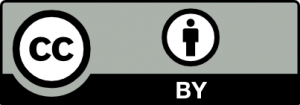
CC BY License Button. Trademark: Creative Commons.
What should creators consider before applying a CC license or CC0 to their work? There are several options for creators who choose to share using CC. There are also many things to think about before applying any CC license or CC0, including whether you have all the rights you need and if not, how you must indicate that to the public.
How would you go about choosing a particular CC license for your work? Do you know how to go about actually attaching a license to your work once you have chosen one? What if you change your mind about the license?
Before you decide that you want to apply a Creative Commons license or CC0 to your creative work, there are some important things to consider:
The licenses and CC0 are irrevocable. Irrevocable means a legal agreement that cannot be canceled. That means once you apply a CC license to a work, the CC license applies to the work until the copyright on the work expires. This aspect of CC licensing is highly desirable from the perspective of reusers because they have confidence knowing the creator can’t arbitrarily pull back the rights granted them under the CC license.
Because the licenses are irrevocable, it is very important to carefully consider the options before deciding to use a CC license on a work.
You must own or control copyright in the work. You should control copyright in the work to which you apply the license. For example, you don’t own or control any copyright in a work that is in the public domain, and you don’t own or control the copyright to an Enrique Iglesias song. Further, if you created the material in the scope of your employment, you may not be the holder of the rights and may need to get permission from your employer before applying a CC license. Before licensing, be mindful about whether you have copyright to the work to which you’re applying a CC license. Visit Unit 2.1 to review Copyright basics.
The six Creative Commons licenses provide a range of options for creators who want to share their work with the public while still retaining copyright. The best way to decide which license is appropriate for you is to think about why you want to share and how you hope others will use your work.
For example, here are a few questions to consider:
If you need some help deciding which license might be best for you, this flowchart from CC Australia might be useful (please note the information it contains is not legal advice and was created before CC offered 4.0 licenses): http://creativecommons.org.au/learn/fact-sheets/licensing-flowchart/
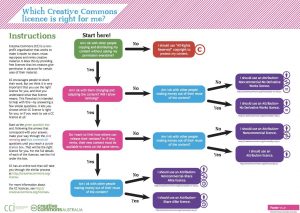
Which Creative Commons license is right for me by CC Australia. CC BY
Once you’ve decided you want to use a CC license and know which license you want to use, applying it is simple. Technically, all you have to do is indicate which CC license you are applying to your work. However, we strongly recommend including a link (or writing out the CC licence URL, if you are working offline) to the relevant CC license deed (e.g., https://creativecommons.org/licenses/by/4.0). You can do this in the copyright notice for your work, on the footer of your website, or any other place that makes sense in light of the particular format and medium of your work. The important thing is to make it clear what the CC license covers and locate the notice in a place that makes that clear to the public. See Marking your work with a CC license for more information.
Indicating which CC license you choose can be as simple as this notice from the footer of BC Open Textbooks.

Except where otherwise noted, content on this site is licensed under a Commons Attribution 4.0 International License
If you are on a platform like Medium or Flickr, you should use the built-in CC licence tools on the platform to mark your work with the CC license you choose.
If you have a personal blog or a website, we recommend using the CC license chooser to generate code that identifies your chosen license. That code can be copied and inserted into your work online.
Take some time to play around with the CC license chooser now. After you select the boxes that indicate your preferences, the chooser generates the appropriate license based on your selections. Remember, the license chooser is not a registration page, it simply provides you with standardized HTML code, icons and license statements.
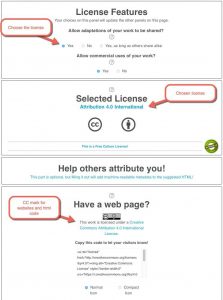
For examples of CC licenses applied to different creations, from videos to off-line documents, view this CC Wiki on Marking Your Work with a CC license. And explore our licensing examples page.
Do you see the text and icon just above the code? That text / links can also be copied and pasted onto your work to mark the work with a CC license.
Like the licenses, CC0 has its own chooser. If you want to dedicate your work to the public domain, you can go to https://creativecommons.org/choose/zero/waiver. Complete the required fields, agree to the terms, and then get the metadata to mark your work with CC0.
If you want to mark the work in a different way or need to use a different format like closing titles in a video, you can visit https://creativecommons.org/about/downloads/ and access downloadable versions of all of the CC icons.
Whatever method you use to mark your content, there are several important steps for proper CC license marking. Here are three cases in which you will mark CC licensed works:
When providing attribution, the goal is to mark the work with full TASL information. When you don’t have some of the TASL information about a work, do the best you can and include as much detail as possible in the marking statement.
Note, that starting with Version 4.0 the licenses no longer require a reuser to include the title as part of the attribution statement. However, if the title is provided, then CC encourages you to include it when attributing the author.
For more examples of how to mark your own work in different contexts, spend some time looking through CC’s extensive marking page.
See below for an example of marking an image with TASL information. The following image is a good example of CC marking because TASL with all appropriate links is provided in the attribution statement.
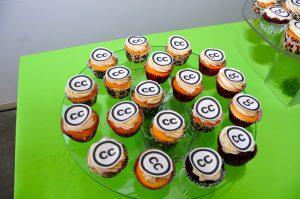
Creative Commons 10th Birthday Celebration San Francisco by tvol. CC BY 2.0
2. Indicating if your work is based on someone else’s work – If your work is a modification or adaptation of another work, indicate this and provide attribution to the creator of the original work. You should also include a link to the work you modified and indicate what license applies to that work.
Example here:

This work, “90fied”, is a derivative of “Creative Commons 10th Birthday Celebration San Francisco” by tvol, used under CC BY. “90fied” is licensed under CC BY by [Your name here].
3. Marking work created by others that you are incorporating into your own work
Example here from a Saylor Academy course:
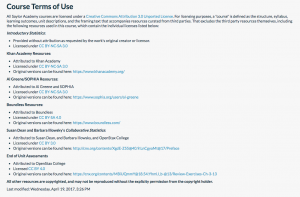
In every case, the goals are the same: you want to make it easy for others to know who created what parts of the work. (1) Identify the terms under which any given work, or part of a work, can be used. (2) Provide information about works you used to create your new work or incorporated into your work.
When applying a CC license to a work: 1) Use the CC license chooser to determine which CC license best meets your needs. Apply the license code if possible, or copy / paste the text and links provided. 2) If you are using an online platform, use the built-in CC license tools to mark your work with a CC license. 3) Mark your work and give proper attribution to others’ works using the TASL approach.
There is no single answer for which CC license is the best. It is important to remember why you are sharing and what you hope others might do with your work, before making your CC license choice.
4.1 Choosing and Applying a CC License from Creative Commons Certificate for Educators and Librarians is available under a Creative Commons Attribution 4.0 International license
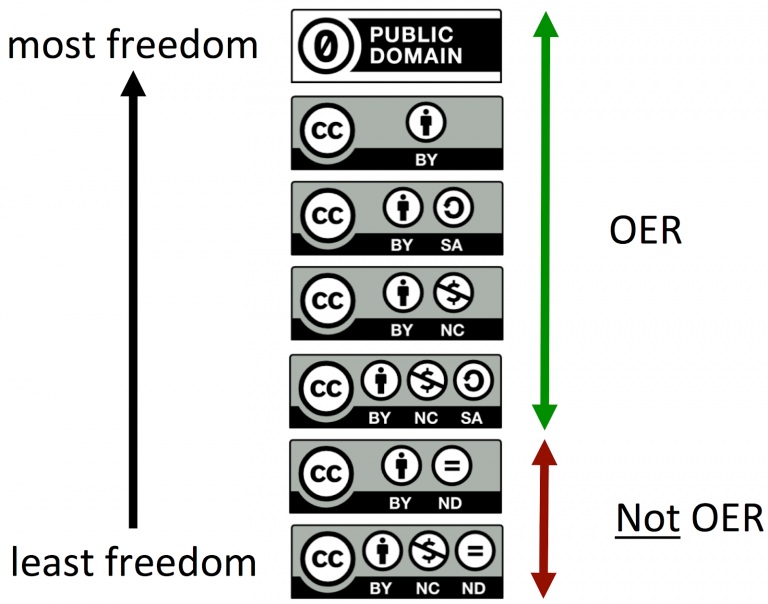
(Image by Cable Green.)
Simply having a Creative Commons license does not make something a fully open resource. ND stands for No Derivatives, meaning the work cannot be modified or remixed. Since the option to revise or remix is a key aspect of an open resource, sources with an ND restriction are not fully open. You are still free to use the work as-is if that works for you and your course!
Terms of use:
The OER libguide by PGCC Library is licensed under a CC BY-NC-SA 4.0. It is attributed to UMGC, Butler County Community College, D'Arcy Hutchings and the original versions can be found at UMGC, BCCC, and Hutchings.